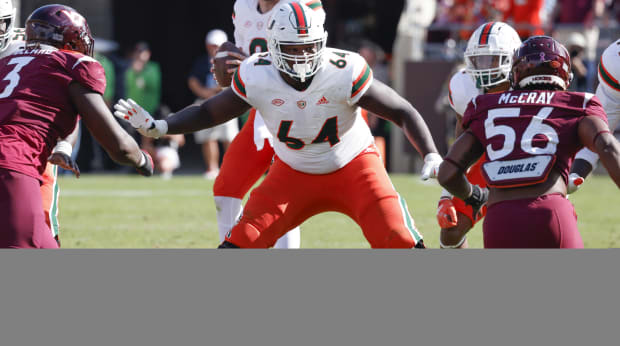CHARLOTTE—New Miami center Matt Lee will have played on a wide swath of the offensive tempo spectrum when all is said and done for his college career. A UCF transfer, Lee spent the earliest parts of his college days under Josh Heupel in an offense that injects fast pace into absolutely everything it does, even instructing ballcarriers who go down on which ref to hand the ball to in order to restart the play as quickly as possible. Then entered Gus Malzahn, who made a name for himself for going fast, but maybe not as fast as the now-Tennessee head man whose Vols were second in the nation at 20.1 seconds per play. Lee transferred to finish his college career at Miami, where depending on how new offensive coordinator Shannon Dawson calls a game, the Canes have the ability to drop the hammer, or play at the more moderate pace a Mario Cristobal-coached team is used to operating on. Why’s it matter? Well, when you’re a center and you’re calling the shots on the most important position group on the offense besides quarterback, time is of the essence.
“At some point you’ve either gotta prioritize identifying and being everyone hat on a hat perfectly or you want to prioritize your tempo,” Lee said, speaking at ACC media day. “With Heupel it’s tempo tempo tempo, it’s get it hiked and let’s go play football.”
These Canes might just huddle at times, which for some college football teams is a truly lost art.
“I think that helps a lot especially if you want to call pretty complex run game concepts with certain personnel that brings its own wrinkles with it,” Lee said. “Being able to get on the ball and identify [defenses] truly, and have more than a few seconds to make a front call, I’m gonna point back at [the front], I’m gonna call my double team, I’m gonna call [my teammate’s] double team, I’m gonna tell them what to do. Everyone has a couple more seconds to be right.”
All of this is important not just because of the O-line’s value to a team, but specifically to Miami. The Canes were merely average up front and were middle-of-the-road at best in most advanced statistical categories. The most important OL counting stat wasn’t kind to them either: 100th in sacks allowed with 36. The Canes’ front will look almost unrecognizable from the starting five that played last season. Left tackle Zion Nelson is still not yet cleared from the injury that forced him to miss all but one game last season. If he is back at full power, his potential is high. He’ll be next to Alabama transfer Javion Cohen at left guard then Lee at center. One of Jakai Clark, Jalen Rivers or Anez Cooper may slot in at right guard (each were on the team last season) and at right tackle it’s likely one of Miami’s highly touted five-star freshmen Francis Mauigoa or Samson Okunlola.

Reinhold Matay/USA TODAY Sports
“It’s a different offensive line from a power, balance, body control, foot/body quickness, heavy-handed guys that play with a mentality and a demeanor that you want,” head coach Mario Cristobal said. “The way we coach it up—coach [Alex] Mirabal is our offensive line coach—I always tell people I’m the assistant offensive line coach during the year. I spend a ton of time over there and with the tight ends and the special teams. That position, along with the defensive line, requires several sets of eyes. They are jelling and they are jelling well. They spend a lot of time together, sometimes by choice and sometimes we give them no choice. They’re made of the right stuff. They’re invested, that offensive line is something we are really really excited about.”
Cristobal, a former offensive lineman himself, takes particular pride in that unit. He and Mirabal believe strongly in cross training players—especially guards and tackles—to learn more than one position along the line. It’s a tactic that, with careful allocation of practice reps, can be executed to the benefit of the entire line of scrimmage. Perhaps the No. 1 right tackle can work at his position for a few plays, then work at left tackle for a few other plays. This lets the starting left tackle rest, and maybe he could get some work at guard. It sounds simple, but the musical chairs can be difficult to balance with one of the biggest position groups on the team. It takes proper organization and communication to make sure everything works.
Watch college football with fuboTV. Start your free trial today.
“The best example I could give you is Penei Sewell,” Cristobal said. “No. [7] pick in the Draft, starting left tackle. Outland winner. All-American. Gets drafted by the Detroit Lions, gets tapped on the shoulder ‘hey buddy you’re going to right tackle.’ On our team there are gonna be issues and injuries and someone’s gonna have to move. You’re better off moving one piece than two pieces. The more pieces you move, the more the multiples become more difficult. It’s also our job not just to help them to get to the NFL, but our job to help them stay in the NFL and build their career. That’s the only way to have a chance to build long sustaining generational wealth. “
Cohen has experience playing both guard and tackle and Lee spent the early part of his career at guard at UCF. For Miami to get back to where it wants to get to after a disappointing 2022, it’ll need its retooled offensive line to use positional versatility as its strength.







